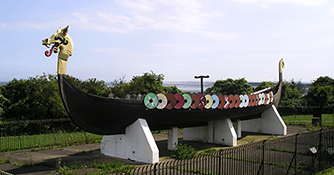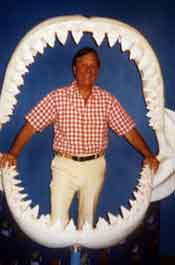CRUISE SHIP LECTURES :
Footprints of the Vikings
Dr John Augelli shares his insight on the Vikings in these notes from one of his cruise ship lectures.
FOOTPRINTS OF THE VIKINGS

I suspect that among the younger generations, the term “Vikings” is more readily associated with a Minnesota football team than with the Nordic adventurers who once terrorized much of Europe and left their footprints on several places to be visited on a cruise.
But even among those of us who are older and know better, it is surprising how few are aware of the extent and impact of those long ago sea rovers. Although they are often thought of primarily as raiders, the Vikings were also traders, explorers, conquerors and settlers, whose legacy is seldom appreciated. In the words of one English observer commenting about the teaching of his country’s history, “the Vikings are one of the best kept secrets of English history. They have been treated as a passing phenomenon which came and went, rather like the dinosaurs of the Jurassic Age”. In American history, the Vikings either go totally unmentioned or are given a footnote alluding to Lief Ericson and Vinland.
This presentation can be little more than a bare bone outline of the Viking saga. I propose to be highly selective as to which sub-themes to touch in attempting to address questions such as: Who were these Vikings? How, why and when did they explode on the European scene and consciousness ? What was the nature and extent of their impact? What is the current evidence of this impact? When and why did they fade from center stage?
The term “Vikings” is broadly used to identify the people of Scandinavia between 800 and 1100 A D, and especially those who wandered from their homelands to raid, trade and sometimes settle abroad. Their zones of operation and impact included the Baltic, the North, the Irish and the Mediterranean seas, and the rivers of both eastern and western Europe. They also moved onto the North Atlantic to settle Iceland and Greenland and eventually reach America. In Old Norse, the verb “vika” means “to go off”, and it may have been from this word that the name “Viking” emerged.
More important it would appear that the Vikings had to “go off” whether they liked it or not. Men became Vikings not by choice, but by necessity. Viking Age Scandinavia was a tough place in which to make a living. Much of the area was either climatically (or otherwise) totally unsuited for agriculture; other sectors were at best marginal for crop production, and a slight change in climate or simply a year of bad weather could result in crop failure leading to famine. For example, quoting from a work entitled the “Saga of the Goths”, describing conditions in parts of Scandinavia during the 6th Century, the author said, “Once there was a big famine in Oland, and a third of the people had to move away just as they had been forced to do in the past”
Because farm production was both limited and uncertain, the early Scandinavians had to supplement their income by animal husbandry, hunting, gathering and above all, fishing. They turned to the sea for food and in the process their experience expanded. They became sea oriented, learning to excel in boat construction, navigation and the use of waterways for trading and raiding. It is estimated, for example, that the Scandinavians had already had 1,000 years of experience in building and manning boats on the North Sea before the Viking Era.
Contact between Scandinavia and the rest of Europe had begun well before the Viking period. Various People from the general region had migrated southward. As early as the second century BC for example, the Cimbri, a tribe native to Jutland had invaded Roman Gaul. While the Roman Empire was under attack from Germanic tribes in the 5th Century AD, the Angles and the Jutes from Denmark were already appearing in Britain. But these pre-Viking era movements of Nordic folk were limited both in scope and duration. It was the Viking forays and migrations beginning in the late 8th and continuing into the 11th Century that were the most sustaining and wide-ranging folk movements from Scandinavia.
Trading between Scandinavia and the rest of Europe had also begun before the Viking period, but it greatly expanded going hand-in-hand with raiding during heyday of the Vikings. Trade goods from Scandinavia included pelts, combs made from reindeer antlers, whetstones, fish, amber as well as slaves captured in raids. Initial trading contact was with Frisian traders who came to the Baltic in the late 8th Century. Later, as we shall see, the Vikings pushed out and established a trading presence on the south shore of the Baltic, and in both western and eastern Europe. In exchange for their products, the Vikings received silver, silks, glassware and other high value easily transported luxury goods that represented wealth and prestige in their Scandinavian homeland. It should be noted, however, that except as a source of nuisance and piratical raiders, the Nordic region was of little economic and political significance to the rest of Europe during the Viking Age.
But the fame (or infamy) of the Vikings rests not so much on their trade as on their murderous raids, conquests, explorations and eventual settlement. The foci of their activities lend themselves into a threefold geographic division each roughly associated with one Viking group; western Europe which was the sphere of interest of the Danish and Norwegian Vikings; eastern Europe where the Swedes were most active; and the north Atlantic to Iceland, Greenland, and America which, while primarily Norwegian, may have combined elements from all three groups.
Expansion to and exploration of Western Europe
The “going off” of the Vikings began in earnest during the late 8th Century. Using swift, shallow-drafted ships propelled both by sail and oars, (about which, later) the Vikings began to raid the coasts of Britain and France. In 793, they pillaged the Lindisfarne Monastary on the east coast of England. The rich monasteries of Ireland also became early targets. (From the fury of the Norsmen, Mary spare us, became a fervent prayer of the Irish monks.) Beginning in the 9th Century and for the next couple hundred years, the pattern of raids expanded so as to encompass much of Europe and the Mediterranean. At first the raids were seasonal and isolated. The practice was for small bands of Vikings to operate abroad in the spring and summer, returning home for the winter. Later, the bands grew in size and began to establish permanent bases along the coasts and even the interior of Europe.
Thus by 845, the Vikings (primarily Danish and Norse) had established year round bases at the mouths of the Loire and Thames Rivers facilitating further incursions into France and England. By 865 the Vikings had conquered East Anglia, Northumbria, and much of Mercia in Britain, and by 878, Danish Vikings had control over large parts of eastern and northern England, a territory that became known as the Danelaw. The Danish Vikings gave two kings to England, Sweyn and Canute, and the Scandinavian presence permanently affected English social structures, local dialects and names. The English language contains hundreds of words and place names of Old Norse origins. Elsewhere in the British Isles, Norse Vikings had established bases in Scotland and Ireland; and held sway over the Isle of Man, the Orkneys , the Shetlands, the Hebrides, and further off, the Faroes.
In France, the Vikings resorted to some blackmailing, demanding ever increasing protection payments from the Franks and the city of Paris. They exerted such pressure that by 911, the Viking chief Rollo was given the lands in the lower Seine in return for his promise to guard the river approaches to Paris. This marked the beginning of what became Normandy or the land of the Norsemen or Normans. fAs an aside, the Normans developed a special history of their own. They persisted in their conquering ways, and in 1066 AD, William, Duke of Normandy defeated the English at the Battle of Hastings, and the Norman barons who accompanied him became the backbone of the English and Irish aristocracy. Less well known, the Normans also went on to establish principalities in southern Italy and Sicily in the 11th-12th Centuries. In Normandy itself, to this day the Viking legacy is apparent in the local dialect, in place names such as Omonville, Hatainville, Gonneville etc. and even in family names (Angot, Burnouf, Turgis, Yngouf, and others.
In Ireland, as already noted, the Vikings began by raiding the monasteries, and returning home with their booty. Later, as they did in England and France, they established permanent bases that gave rise to towns such as Dublin, Cork, Waterford, Limerick and others. The Irish Vikings eventually became integrated with the life of the country, but for many years, they retained close contacts with Vikings elsewhere.
Viking thrust into Eastern Europe
While the Danes and Norwegians were concerned with Western Europe, it was the Swedes (and Gotlandic people ) that provided the Viking thrust into Eastern Europe. As in the west, the Vikings combined trading, raiding and ultimate conquest in the east, especially present day Russia. The trade routes from Scandinavia ran along the Baltic with bases in Estonia and southward along the rivers in Russia, such as the Don, Dnieper and the Volga and ultimately to the Byzantine capital of Constantinople and even to Persia and other Moslem areas. One observer who called Estonia “a house beside the road” described the Viking approach as follows. “They came with ships, each with 30 men aboard. Once on shore, they looked for people to rob. If the people (Estonians) were too strong, they reverted to trade instead. To achieve this, they made a truce and exchanged hostages. After the truce, anything could happen. (this technique appears to have been used by all the Vikings.)
Although the Swedish Vikings or Varangians, as they were called, were first attracted to Russia by the aforementioned river trade, they eventually conquered much of Slavic Russia during the 8th and 9th Centuries. (As in western Europe, raids and trade were followed by conquest.) The Varangians in Russia established Novgorod the Great in the north as a city state, but continued their southward push leading to the establishment of Kiev (in present Ukraine) as their capital. Their holdings became known as Kievian Russia, and formed the basis of the later Russian Empire. From Kiev, the Vikings were bold enough to try to take Constantinople, the capital of the Byzantine Empire. They failed, but so impressed the Byzantines as warriors that they were given employment by the Byzantine emperor as an elite military unit called the Varangian Guard. Since Byzantium was too strong to be conquered, the Vikings (as usual) made commercial treaties with them. As elsewhere in Europe, the Vikings of Russia were absorbed by the native (Slavic) population, and their blood flows in some of the most distinguished families of Russia.( Incidentally, one theory concerning the origins of the name ”Russia” is that it stemmed from “Rus”, the name of one of the Varangian tribes.)
Crossing the Atlantic
The Viking Age was also a period of emigration, especially from Norway. Thus, after conquering and establishing themselves in the island region of the Orkneys, the Shetlands and Faroes, the Vikings thrust boldly across the Atlantic to Iceland, Greenland, and ultimately, America. These new regions were of little use for trade and raid, but they had virgin soils that could be used for farming colonization, especially since the Faroes, Iceland and Greeland were uninhabited when the Norsemen arrived. They had settled Iceland by 900 AD. Later in the century, hundreds of Norsemen established farms on the uninhabited shore and inland bays of southern and southwestern Greenland, but their descendants had disappeared by the early 15th Century.
The most intriguing Viking settlement effort, of course, was in North America. It is now well established that Vikings under Leif Erikson called the Lucky, reached America about 1000 AD. The first expedition was supposedly followed by a second visit under Leif’s brother, Thorvald circa 1003; the third and final expedition was under the leadership of Erik the Red’s daughter, Freydis in 1013. The visits to America are recorded in old Norse (Icelandic) sagas.
Precisely where the Vikings landed and established settlements in North America is not totally clear. It seems logical to assume that sailing westward on the Atlantic from Iceland, Leif Erikson landed in what is now East or Northeast Canada. But differences in the interpretation of old Icelandic sagas had him landing as far south as Manhattan. (One author of Scandinavian descent convinced himself, at least, that the Vikings actually reached Minnesota.) Archeologists in the 1960s found the site of Viking dwellings on the north coast of Newfoundland at L’Anse aux Meadows that were like those in Iceland and Greenland at the time. They also found Norse artifacts at the site that dated to circa 1000. But Viking settlements in Vinland (Wineland) did not survive, and what happened to them is still a mystery.
The end of the Viking era
The Viking Era essentially ended between 1000 and 1100 AD. By this time, the Scandinavians had become Christian, and the conversion had a restrictive effect on their tendency to plunder. Also by this time, the Vikings had become a more integral part of Europe adopting many of the political, economic and social institutions and practices of the continent. In short, the Nordic countries became “civilized” members of the general European community of states, each with its own king. Except for the Faroes and Iceland that retain their Nordic ties to this day, the Viking impact on other countries such as the Britain, Ireland, France and Russia has been absorbed and often goes unrecognized except by historians and archeologists.
In retrospect, there is much about the Viking Age that remains challenging, especially how they were able to roam so far and wide on the unknown Atlantic and subdue countries with much larger populations than Scandinavia. Perhaps the most important instrument in the Viking expansion and saga was their attack ship. It was square rigged with a mast at mid-ship, with oars that could be used in a calm or a strong headwind. With its flexible hull and its keel and sail and its light draft, the ship was superior to those of any other people in Europe at the time. It was small, swift and independent of harbors. It could readily reach a coast where no attack was expected; it could beat a quick retreat before a counter attack could be mounted; and it made possible the surprise attack and withdrawal that became the primary tactic of Viking raiders. The attack ship carried a crew of some 30 men.
As the Viking period progressed, ships more suited to trade were developed. These were less swift, carried a smaller crew, had a greater girth to permit more cargo and were more suitable for sailing than to oars.
The ships, of course, were not only necessary for raid and trade, they were also of crucial importance in colonization, when entire families and their possessions, including livestock sailed to new lands. The Viking thrust across the perilous North Atlantic is evidence that their ships were very seaworthy. Even today, the Viking genius for building ships looms awesome. And so it goes.

